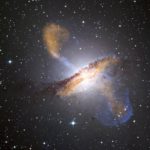NASA Announces Updated Crew Assignments for Space Station Missions NASA is announcing an addition to the NASA lineup for upcoming launches, and making changes to some assignments for International Space Station missions in 2018.
<em>Author</em> Conquest Space News
Astronomers Pursue Renegade Supermassive Black Hole Supermassive black holes are generally stationary objects, sitting at the centers of most galaxies. However, using data from NASA’s Chandra X-ray Observatory and other telescopes, astronomers recently hunted down what could be a supermassive black hole that may be on the move.
Watching a Volatile Stellar Relationship In biology, “symbiosis” refers to two organisms that live close to and interact with one another. Astronomers have long studied a class of stars – called symbiotic stars – that co-exist in a similar way. Astronomers are gaining a better understanding of how volatile this close stellar relationship can be.
Chandra Samples Galactic Goulash Arp 299 is a system located about 140 million light years from Earth. It contains two galaxies that are merging, creating a partially blended mix of stars from each galaxy. New data from Chandra reveals 25 bright X-ray sources sprinkled throughout the Arp 299 concoction, that astronomers categorize them as « ultra-luminous
Chandra Peers into a Nurturing Cloud The giant molecular cloud known as W51 is one of the closest to Earth at a distance of about 17,000 light years. Because of its relative proximity, W51 provides astronomers with an excellent opportunity to study how stars are forming in our Milky Way galaxy.
A Starburst with the Prospect of Gravitational Waves More than a hundred years after Swift’s discovery of the « starburst » galaxy IC 10, astronomers are studying IC 10 with the most powerful telescopes of the 21st century.
Two Stars, Three Dimensions, and Oodles of Energy For decades, astronomers have known about irregular outbursts from the double star system V745 Sco. When the system erupted on February 6, 2014, however, scientists were ready to observe the event with a suite of telescopes including NASA’s Chandra X-ray Observatory.
Chandra Makes First Detection of X-Rays from a Gravitational Wave Source Astronomers have used NASA’s Chandra X-ray Observatory to make the first X-ray detection of a gravitational wave source. Chandra was one of multiple observatories to detect the aftermath of this gravitational wave event, the first to produce an electromagnetic signal of any type.
The Dynamic Duo: Jupiter’s Independently Pulsating X-ray Auroras Jupiter’s intense northern and southern lights, or auroras, behave independently of each other according to a new study using NASA’s Chandra X-ray and ESA’s XMM-Newton observatories.
Chandra Reveals the Elementary Nature of Cassiopeia A Due to its unique evolutionary status, Cassiopeia A (Cas A) is one of the most intensely studied of these supernova remnants.





